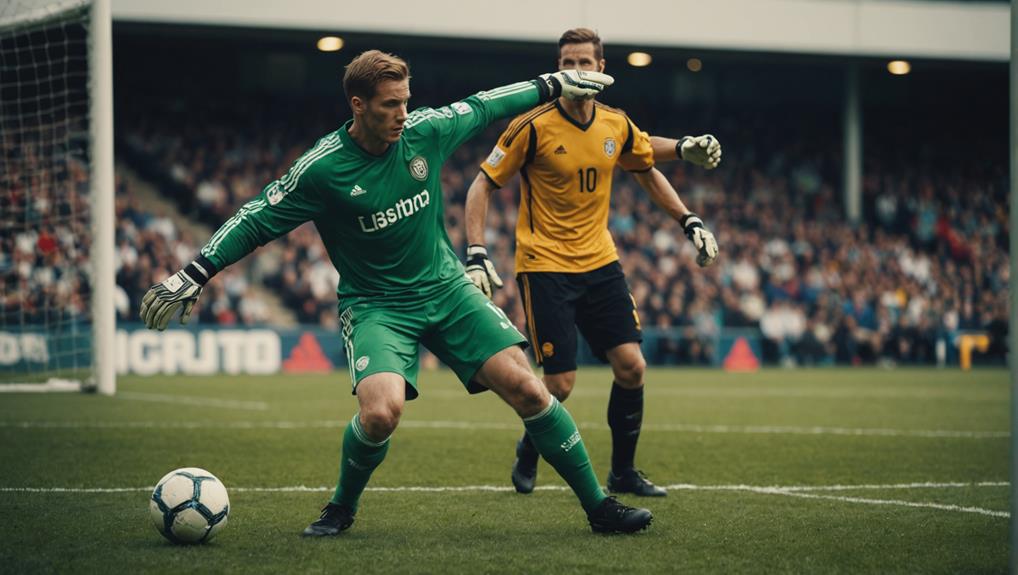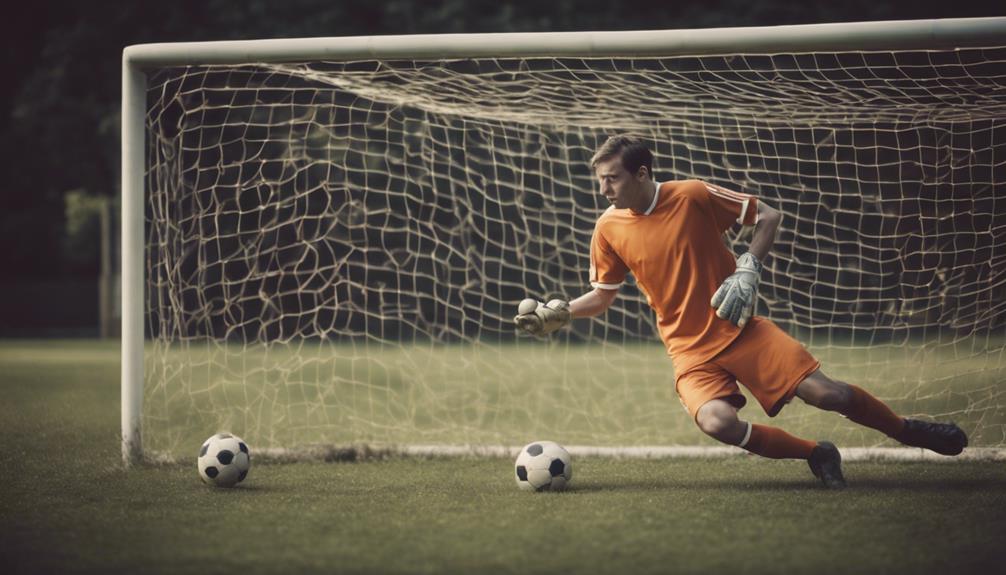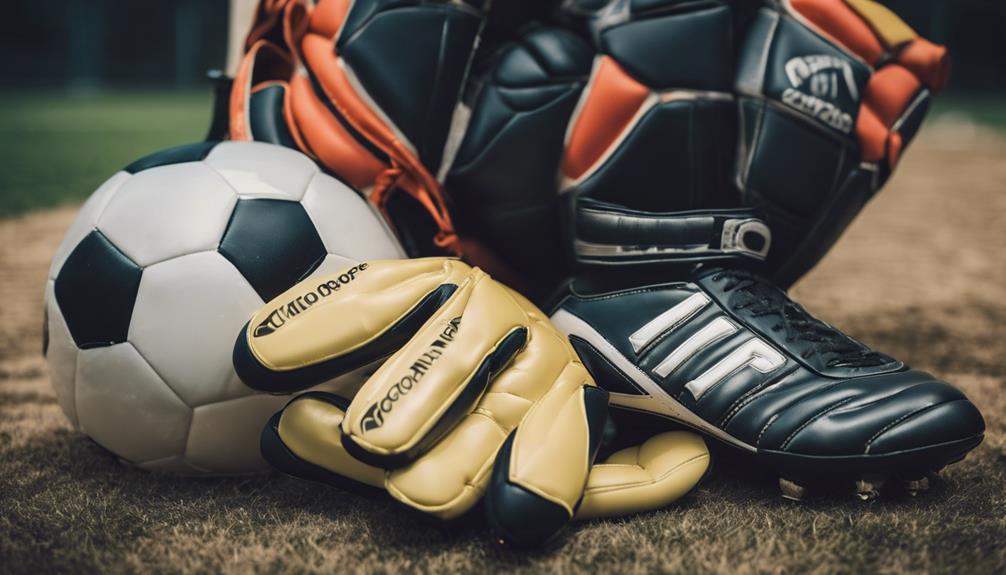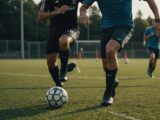
Essential Rules for Soccer Goalies
August 5, 2024As a soccer goalie, you must know the key rules of your position. Stay alert within the 6-yard box surrounding the goal, where you can handle the ball with your hands but can't pick up a back pass. Penalty kicks occur 12 yards from the goal line, and it's important to follow the guidelines established for your position. Wearing distinct clothing, understanding play-restarting protocols, and adherence to time limits and equipment regulations are all essential for your success on the field. Mastering these rules will elevate your performance and keep you sharp during gameplay.
Goalkeeper Box Rules
When playing as a soccer goalie, understanding the rules within the goalkeeper box is vital for effectively defending your goal. The goalkeeper box extends 6 yards from each side of the goal and is where goal kicks and free kicks are taken by the defending team.
Goal kicks allow the goalie to restart play after the ball goes past the end line, while free kicks for the attacking team are taken near the 6-yard line after offenses in the goal area.
Within the goalie box, goalkeepers have the privilege to handle the ball with their hands, dictating play within this restricted area. Defending team players must be positioned outside the penalty area during a goal kick.
Fouls against the goalkeeper can lead to free kicks for the opposing team. The goalie box rules grant goalkeepers the authority to take goal kicks and make strategic moves to protect the goal effectively.
Understanding these goalkeeper restrictions and guidelines within the goalkeeper box is essential for a successful defensive strategy.
Penalty Area Guidelines
Within the penalty area in soccer, goalkeepers are granted the unique privilege of using their hands to handle the ball during gameplay. This area extends 18 yards from the goal line, and only the goalkeeper is allowed to handle the ball with their hands within this zone.
Defending players must be cautious as any foul infractions they commit within the penalty area can lead to penalty kicks for the opposing team. Penalty kicks are taken from the penalty spot, situated 12 yards from the goal line inside the penalty area.
Additionally, the penalty arc at the top of the penalty area serves as a guide for positioning during penalty kicks. It's vital for goalkeepers to understand and adhere to penalty guidelines and rules to effectively defend their goal and prevent the opposing team from capitalizing on penalty opportunities.
Familiarizing oneself with these regulations can greatly impact a goalkeeper's performance within the penalty area.
Ball Handling Regulations

Goalkeepers are allowed to handle the ball using their hands within the penalty area in soccer. However, if a teammate intentionally passes the ball back using their feet, the goalkeeper can't pick it up with their hands.
In such instances, the goalkeeper must use their feet to play the ball. When in possession, goalkeepers have the option to kick or throw the ball to restart play. They're easily recognizable on the field by wearing distinct clothing that sets them apart from outfield players.
Unlike in other situations, goalkeepers don't typically use their hands during a throw-in. It's essential for goalkeepers to adhere to these ball-handling regulations to avoid penalties and ensure fair play. By understanding and following these rules, goalkeepers can effectively contribute to their team's success and maintain a strong defensive presence on the field.
Time Limit Restrictions
As a goalie, managing your time effectively is vital when in possession of the ball. Remember, you have only 6 seconds to distribute the ball to a teammate before facing consequences.
This time limit not only impacts your performance but also influences the overall flow of the game.
Time Management for Goalies
To guarantee fair play and maintain the pace of the game, goalkeepers must release the ball within a 6-second time limit once they gain possession. This time limit, known as the 6-second rule, requires goalkeepers to make quick decisions to avoid penalties.
Effective time management is essential for goalkeepers to adhere to this rule and prevent giving the opponent an indirect free kick.
Referees play a pivotal role in enforcing the 6-second time limit, ensuring fairness and keeping the game flowing smoothly. Goalkeepers need to be aware of this rule during any method of ball possession to avoid infringements.
Quick decision-making is a skill goalkeepers must master to release the ball promptly while under pressure.
Enforcement of 6 Seconds
Implementing the 6-second time limit for goalkeepers guarantees a fair and efficient gameplay experience for both teams. Goalkeepers must be aware of the 6 seconds rule, which dictates that they can't hold the ball for more than the specified time before releasing it. This restriction applies to all forms of ball control, including holding and dribbling. Referees enforce this rule to prevent time-wasting tactics and maintain the pace of the game. Failure to comply with the 6-second limit results in the opposing team being awarded an indirect free kick.
Enforcement of the 6-second rule emphasizes the importance of quick decision-making for goalkeepers. They must assess their options promptly and release the ball within the stipulated time to avoid penalties. By adhering to this regulation, goalkeepers contribute to the smooth flow of the game and demonstrate their commitment to fair play. Compliance with the 6-second time limit showcases a goalkeeper's ability to make effective choices under pressure while upholding the principles of sportsmanship.
Impact on Game Flow
Enforcing the 6-second time limit for goalkeepers greatly impacts the flow of the game by promoting quick decision-making and preventing time-wasting tactics. Goalkeepers must efficiently manage their ball control to comply with this rule. Failure to release the ball within the stipulated time results in an indirect free kick for the opposing team, disrupting the team's possession and potentially leading to scoring opportunities for the opponents. Referees play a pivotal role in ensuring that goalkeepers adhere to the time limit, maintaining fairness and the pace of the game.
The 6-second rule necessitates goalkeepers to make swift choices in their distribution of the ball, influencing the momentum of the match. By imposing this restriction, the game flow remains dynamic, encouraging goalkeepers to think and act promptly.
Equipment Requirements

You need to make sure you have the necessary goalkeeper apparel such as jerseys, shorts, socks, shinguards, and appropriate footwear.
Goalkeeper gloves are essential for providing grip, protection, and support during play.
Remember that referees have the final say on the safety and suitability of any additional goalkeeper equipment.
Required Goalkeeper Apparel
Goalkeepers are required to wear a distinct-colored jersey, shorts, socks, shinguards, and footwear to ensure easy identification during play. The jersey is typically long-sleeved and heavily padded to protect the goalkeeper during dives and shots.
Gloves are an essential piece of equipment for goalkeepers, aiding in grip, ball-handling, and protection. While these items are mandatory, optional gear like undershirts, headcovers, and extra padding can be worn with referee approval for safety reasons.
Shinguards are essential for the goalkeeper's lower leg protection, especially when facing powerful shots or colliding with opponents. Footwear must provide proper traction on the field to support quick movements and secure footing.
All these clothing and equipment regulations serve the purpose of distinguishing goalkeepers from outfield players, ensuring that they're easily recognizable by referees and compliant with position-specific rules.
Goalkeeper Glove Importance
When it comes to soccer goalkeeping, the importance of goalkeeper gloves can't be overstated. Goalkeeper gloves play a key role in providing the necessary grip to catch and control the ball effectively during intense gameplay.
Additionally, the padding on these gloves offers essential protection against hard shots and impact injuries, guaranteeing the goalkeeper's safety during matches. Quality goalkeeper gloves not only enhance ball handling skills but also boost the confidence of goalkeepers, allowing them to perform at their peak.
There are different types of goalkeeper gloves available to cater to various needs, including options with finger protection and those designed to withstand different weather conditions. It's essential for goalkeepers to choose gloves that fit properly to prevent hand injuries and ensure top performance on the field.
Equipment Safety Considerations
To ensure player safety and compliance with regulations, soccer goalkeepers are required to wear specific equipment during matches and training sessions. This equipment includes gloves, padded shorts, jerseys, socks, shinguards, and appropriate footwear. It's essential for goalkeepers to wear unique and distinguishable clothing to be easily identified on the field by teammates, opponents, and officials.
While the mentioned items are mandatory, goalkeepers can also opt for additional gear such as undershirts, headcovers, and extra padding to enhance safety based on regulations. Referees hold the authority to evaluate the safety and appropriateness of the goalkeeper's equipment before and during the game. Gloves, in particular, are vital for goalkeepers as they provide grip, protection, and support while playing.
Play Restarting Protocols
Understanding the play restarting protocols is essential for soccer goalies to effectively manage game flow and make strategic decisions.
As a goalkeeper, you have the responsibility to restart play either with a kick or a throw, each governed by specific regulations. Quick decision-making is pivotal as your choice can impact the team's overall strategy.
By following the protocols for restarting play, you not only maintain game flow but also avoid potential infractions that could benefit the opposing team. Whether you opt for a kick or a throw, being aware of the rules guarantees that you make the best decision in the moment.
Conclusion
So, now that you know the essential rules for soccer goalies, it's time to get out on the field and put them into action.
Remember, practice makes perfect, so don't hesitate to immerse yourself headfirst and give it your all.
After all, the early bird catches the worm, and the more you work on your skills, the better you'll become.
Good luck out there, goalie!


